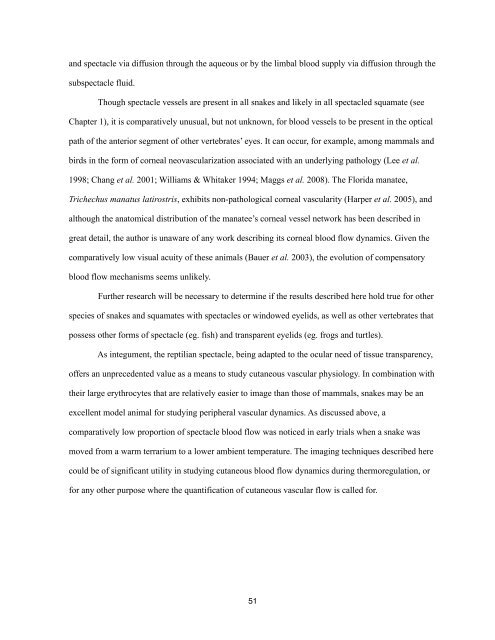Chapter 1, The Reptilian Spectacle - UWSpace - University of ...
Chapter 1, The Reptilian Spectacle - UWSpace - University of ...
Chapter 1, The Reptilian Spectacle - UWSpace - University of ...
You also want an ePaper? Increase the reach of your titles
YUMPU automatically turns print PDFs into web optimized ePapers that Google loves.
and spectacle via diffusion through the aqueous or by the limbal blood supply via diffusion through the<br />
subspectacle fluid.<br />
Though spectacle vessels are present in all snakes and likely in all spectacled squamate (see<br />
<strong>Chapter</strong> 1), it is comparatively unusual, but not unknown, for blood vessels to be present in the optical<br />
path <strong>of</strong> the anterior segment <strong>of</strong> other vertebrates’ eyes. It can occur, for example, among mammals and<br />
birds in the form <strong>of</strong> corneal neovascularization associated with an underlying pathology (Lee et al.<br />
1998; Chang et al. 2001; Williams & Whitaker 1994; Maggs et al. 2008). <strong>The</strong> Florida manatee,<br />
Trichechus manatus latirostris, exhibits non-pathological corneal vascularity (Harper et al. 2005), and<br />
although the anatomical distribution <strong>of</strong> the manatee’s corneal vessel network has been described in<br />
great detail, the author is unaware <strong>of</strong> any work describing its corneal blood flow dynamics. Given the<br />
comparatively low visual acuity <strong>of</strong> these animals (Bauer et al. 2003), the evolution <strong>of</strong> compensatory<br />
blood flow mechanisms seems unlikely.<br />
Further research will be necessary to determine if the results described here hold true for other<br />
species <strong>of</strong> snakes and squamates with spectacles or windowed eyelids, as well as other vertebrates that<br />
possess other forms <strong>of</strong> spectacle (eg. fish) and transparent eyelids (eg. frogs and turtles).<br />
As integument, the reptilian spectacle, being adapted to the ocular need <strong>of</strong> tissue transparency,<br />
<strong>of</strong>fers an unprecedented value as a means to study cutaneous vascular physiology. In combination with<br />
their large erythrocytes that are relatively easier to image than those <strong>of</strong> mammals, snakes may be an<br />
excellent model animal for studying peripheral vascular dynamics. As discussed above, a<br />
comparatively low proportion <strong>of</strong> spectacle blood flow was noticed in early trials when a snake was<br />
moved from a warm terrarium to a lower ambient temperature. <strong>The</strong> imaging techniques described here<br />
could be <strong>of</strong> significant utility in studying cutaneous blood flow dynamics during thermoregulation, or<br />
for any other purpose where the quantification <strong>of</strong> cutaneous vascular flow is called for.<br />
51
















